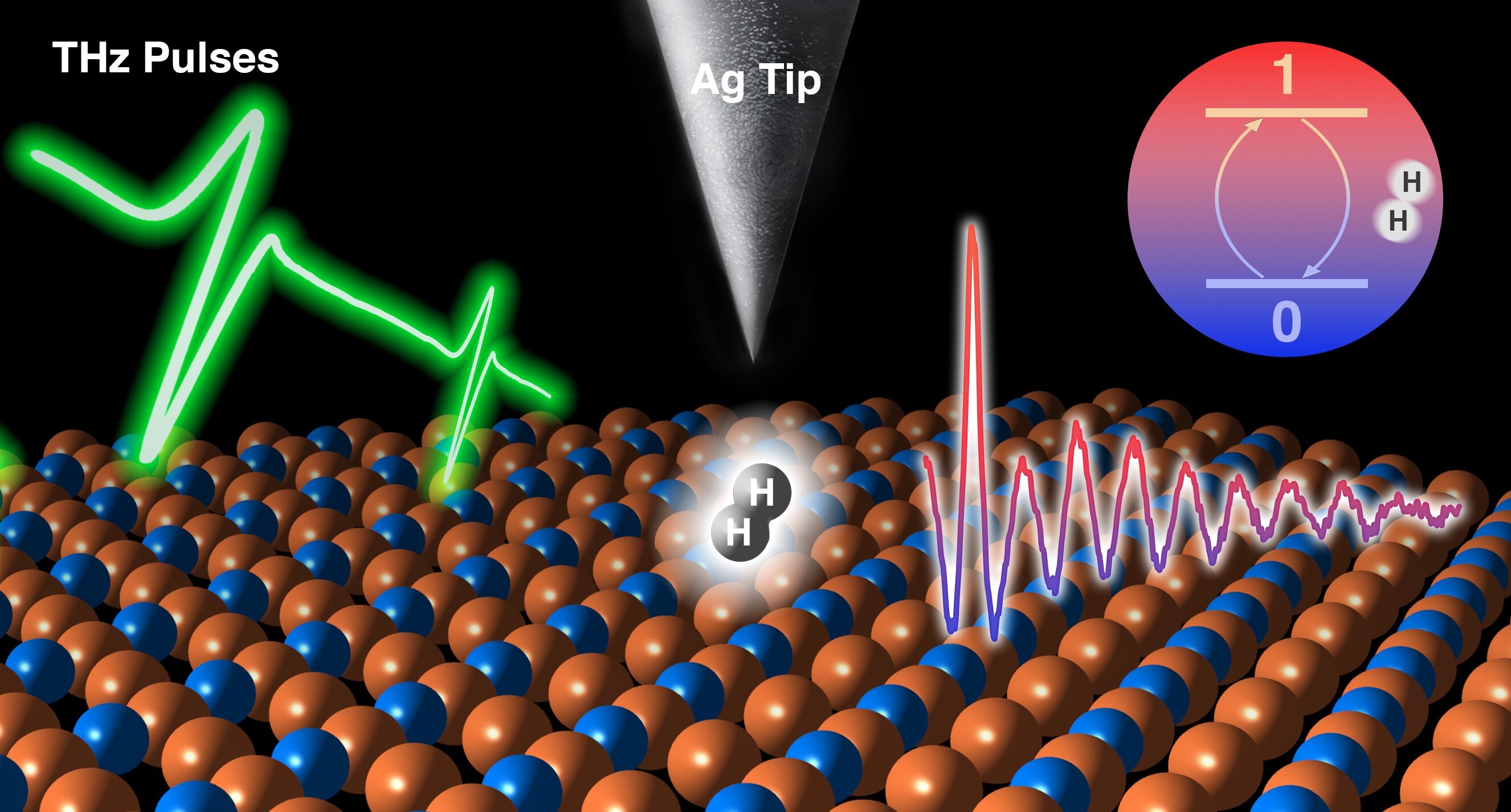博文
科学家们把氢分子变成了量子传感器
 精选
精选
||
科学家们把氢分子变成了量子传感器
诸平
据美国加州大学欧文分校(University of California, Irvine简称UCI)2022年4月22日提供的消息,科学家们把氢分子变成了量子传感器(Scientists turn a hydrogen molecule into a quantum sensor)。上述图1(Fig. 1)是由加州大学欧文分校(UCI)威尔逊·何(Wilson Ho)实验室提供的照片。在扫描隧道显微镜(scanning tunneling microscope简称STM)的超高真空中,一个氢分子被夹在银尖端和样品之间。飞秒的太赫兹激光激发分子,使其变成量子传感器。
UCI的物理学家展示了在太赫兹激光(terahertz laser)扫描隧道显微镜中使用氢分子作为量子传感器,这种技术可以在前所未有的时间和空间分辨率下测量材料的化学性质。这项新技术也可以应用于分析有可能在先进的能源系统、电子和量子计算机中发挥作用的二维材料。相关研究结果于2022年4月21日已经在《科学》(Science)杂志网站发表——Likun Wang, Yunpeng Xia, Wilson Ho. Atomic-scale quantum sensing based on the ultrafast coherence of an H2 molecule in an STM cavity. Science , 21 Apr 2022, 376 (6591): 401-405. DOI: 10.1126/science.abn9220. https://www.science.org/doi/10.1126/science.abn9220
在文中,UCI的物理与天文系和化学系的研究人员描述了他们是如何在扫描隧道显微镜(STM)的银端和一个由氮化铜(copper nitride, Cu2N)小岛排列的平面铜表面组成的样本之间定位两个氢原子的。通过持续万亿分之一秒的激光脉冲,科学家们能够激发氢分子,并在仪器的超低温度和超高真空环境下检测其量子态的变化,绘制出样品的原子尺度、延时图像。
UCI的物理学、天文学和化学方面的布伦教授、此论文的通讯作者威尔逊·何(Wilson Ho)说:“这个项目代表了测量技术和该方法允许我们探索科学问题的进步。一种依赖于探测两能级系统(two-level system)中态的相干叠加的量子显微镜,比现有的非基于量子物理原理的仪器更敏感。”
威尔逊·何说,氢分子是一个两能级系统的例子,因为它的方向在两个位置(向上和向下)之间变化,并略有水平倾斜。通过激光脉冲,科学家们可以诱使系统周期性地从基态进入激发态,从而使两种状态叠加。这种循环振荡的持续时间非常短暂——仅持续几十皮秒——但是通过测量这种“消相干时间(decoherence time)”和循环周期,科学家们能够看到氢分子是如何与其环境相互作用的。
上述图2(Fig. 2)是UCI的斯蒂夫·齐刘斯(Steve Zylius)提供的照片。负责组装和使用太赫兹激光扫描隧道显微镜的UCI团队如图2所示,从左到右,UCI物理与天文学博士生白丹(Dan Bai音译); 物理、天文学和化学布伦教授威尔逊·何; 物理天文学博士研究生夏云鹏(Yunpeng Xia音译)以及化学博士候选人王利坤(Likun Wang音译)。
“氢分子成为了量子显微镜的一部分,在这种意义上,无论显微镜扫描到哪里,氢都在尖端和样本之间,”威尔逊·何说。“它是一个非常敏感的探测器,允许我们看到0.1 Å(0.01 nm)以下的变化。在这个分辨率下,我们可以看到样品上的电荷分布是如何变化的。”
STM尖端和样品之间的空间几乎是难以想象的小,大约6 Å或0.6 nm。威尔逊·何和他的团队组装的STM设备可以检测在这个空间中流动的微小电流,并产生光谱读数,证明氢分子和样品元素的存在。威尔逊·何说,这个实验代表了基于太赫兹诱导整流电流(rectification current)通过单个分子的化学敏感光谱的首次展示。
根据威尔逊·何的说法,基于氢的量子相干性,在这种细节水平上表征材料的能力可以在催化剂的科学和工程中发挥很大的作用,因为它们的功能通常取决于单个原子的表面缺陷。
UCI物理与天文学研究生、该研究的第一作者王利坤说:“只要氢可以被吸附到材料上,原则上,你可以用氢作为传感器,通过观察它们的静电场分布来表征材料本身。”
本研究得到了美国能源部(U.S. Department of Energy: DE-SC0019448)的资助。
上述介绍,仅供参考。欲了解更多信息,敬请注意浏览原文或者相关报道。
ESR-STM on single molecules and molecule-based structures
The coupling of coherent quantum systems to the surrounding environment can be used to create highly sensitive sensors, but many surface-based implementations, such as nitrogen vacancies in diamond, have limited spatial resolution. Wang et al. created a quantum sensor with high spatial sensitivity by using the electric field from a scanning tunneling microscope tip to confine a hydrogen molecule on copper nitride islands grown on a copper surface. Femtosecond-pulse terahertz spectroscopy was used to follow the coherence of the two-level system created by different adsorption geometries. The temporal oscillations and decoherence in the superposition state showed spatial variations at the sub-angstrom scale. —PDS
A scanning tunneling microscope (STM) combined with a pump-probe femtosecond terahertz (THz) laser can enable coherence measurements of single molecules. We report THz pump-probe measurements that demonstrate quantum sensing based on a hydrogen (H2) molecule in the cavity created with an STM tip near a surface. Atomic-scale spatial and femtosecond temporal resolutions were obtained from this quantum coherence. The H2 acts as a two-level system, with its coherent superposition exhibiting extreme sensitivity to the applied electric field and the underlying atomic composition of the copper nitride (Cu2N) monolayer islands grown on a Cu(100) surface. We acquired time-resolved images of THz rectification of H2 over Cu2N islands for variable pump-probe delay times to visualize the heterogeneity of the chemical environment at sub-angstrom scale.
https://blog.sciencenet.cn/blog-212210-1335416.html
上一篇:中国科学家发现空气污染如何改变肺组织,增加癌症易感性
下一篇:酶中的等电荷如何控制生化反应

